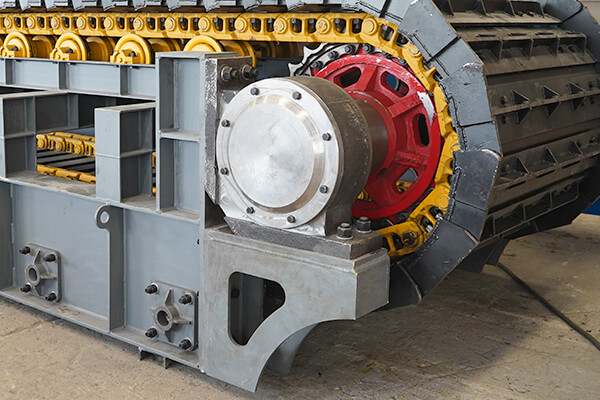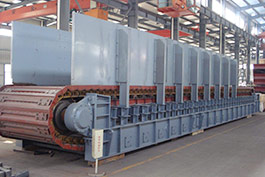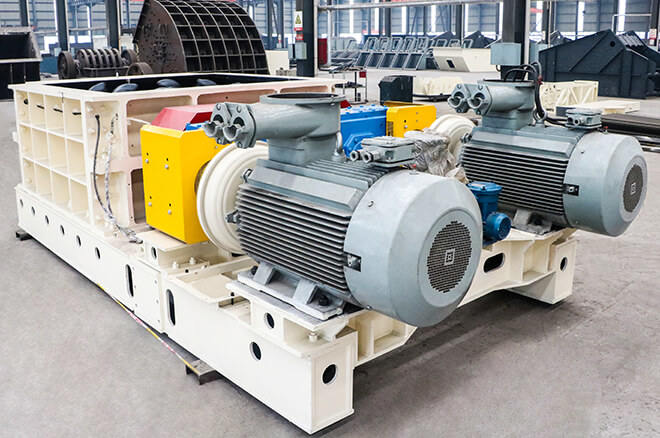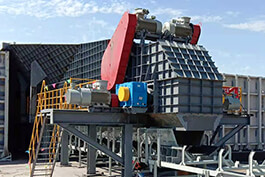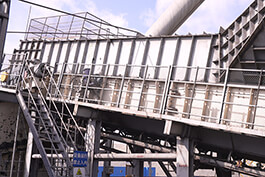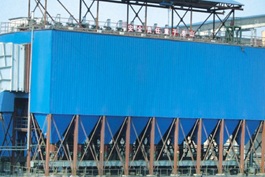In the mining industry, efficient and stable material handling is a key link to ensure the smooth production process. As an important material conveying equipment,
apron feeder is widely used in mining, metallurgy, building materials and many other fields, bearing the heavy responsibility of continuous and uniform supply of materials from the storage bin to the crusher, batching device or other transportation equipment. It can adapt to the harsh working environment, transport large, heavy and abrasive bulk materials, in the entire production system plays an indispensable connection role, directly affecting production efficiency and capacity.
The bearing seat, as one of the key components of apron feeder, is like the joint of the human body, although it seems ordinary, it plays a vital role in the stable operation of the equipment. It is mainly used to support and fix the apron feeder drive shaft, ensure the stability and accuracy of the shaft during operation, withstand the load from the shaft, sprocket and material and other aspects, and transfer the load to the equipment rack. Once the bearing seat fails, it will lead to a decrease in the operating accuracy of apron feeder, resulting in problems such as chain deviation and reduced transmission efficiency, and even lead to equipment downtime in serious cases, which will bring huge economic losses to the enterprise. Therefore, in-depth understanding of the structure, performance and maintenance points of apron feeder bearing seat is of great significance for ensuring the efficient operation of apron feeder and extending the service life of equipment.
Basic composition
The bearing seat of apron feeder is mainly composed of a base, bearing cover, seals and connecting bolts. The various parts work together to ensure the stable operation of the bearing seat.
Base: As the base supporting part of the bearing seat, the base usually adopts a relatively thick structural design to ensure sufficient strength and stability. It is tightly bolted to the apron feeder's frame, reliably transferring the weight and working load of the bearing seat and the entire shafting to the frame, providing a solid support foundation for the entire bearing seat.
Bearing cover: The bearing cover is located on the top of the bearing seat, its main role is to axial positioning and protection of the bearing. It can prevent the axial movement of the bearing during operation and ensure the normal operating position of the shaft. At the same time, it effectively blocks the intrusion of external dust, impurities, moisture and other pollutants into the bearing interior, creating a relatively clean and stable working environment for the bearing, thereby extending the service life of the bearing.
Seals: Seals play a vital sealing role in the bearing seat, and the common sealing forms are labyrinth seals, oil seals and so on. Labyrinth seal through the design of a complex maze structure, the use of air blocking effect to prevent dust, water and other impurities into; the oil seal is an oil seal made of rubber or other elastic materials, which is tightly attached to the shaft to form a sealing barrier. Good sealing performance can ensure that the grease inside the bearing does not leak, maintain the good lubrication state of the bearing, and prevent external pollutants from causing damage to the bearing.
Connection bolts: Connection bolts are used to tightly connect the base, bearing cover, and other related components together to ensure the structural integrity and stability of the entire housing. When selecting the connection bolt, the specification, strength grade and tightening torque of the bolt should be reasonably determined according to the working load and vibration of the bearing seat, so as to ensure the reliability of the connection.
Material selection
The commonly used materials for manufacturing apron feeder bearing seat are cast iron, cast steel, etc. Different materials are suitable for different working scenarios due to their unique performance characteristics.
Cast iron: Cast iron has the advantages of low cost, good casting performance, strong vibration absorption, etc., in some cases where the strength of the bearing seat is not particularly high, and the working environment is relatively stable and the load is small, such as small apron feeder or lighter conveying materials, cast iron bearing seat has been widely used. However, the toughness of cast iron is relatively poor, and it is easy to crack when subjected to a large impact load, so its use in a high impact environment is limited.
Cast steel: Cast steel material has high strength and toughness, can withstand greater load and impact. In the large apron feeder, due to the need to transport large, heavy materials, the bearing seat to bear the load is larger, and the working process may be affected by the material, at this time the cast steel bearing seat becomes a more suitable choice. It can maintain good performance under harsh working conditions and ensure the stable operation of apron feeder, but the cost of casting steel is relatively high and the casting process is more complex.
Assembly relationship with other parts
Bearing seat has a close assembly relationship with spindle, sprocket, chain and other components in apron feeder, and its assembly quality directly affects the overall performance of the equipment.
Assembly with spindle: The spindle is the key part of apron feeder to transfer power and realize material transfer, and the bearing seat is matched with the spindle through its inner hole to provide support and positioning for the spindle. In the assembly process, interference fit or transition fit is usually used to ensure a tight connection between the spindle and the bearing seat to prevent relative displacement during operation. At the same time, it is necessary to ensure the accuracy of the assembly and control the shape and position tolerance of the coaxiality and verticality of the inner hole of the bearing seat and the spindle, otherwise it will cause vibration and noise during the operation of the spindle, affecting the normal operation and service life of the equipment.
Assembly with the sprocket: The sprocket is installed on the spindle and synchronizes with the spindle by key connection or other means. The bearing housing provides a stable support for the sprocket, so that the sprocket can remain stable during operation. When assembling the sprocket, it is necessary to ensure that the installation position of the sprocket is accurate, and the parallelism between the axis and the axis of the main shaft meets the requirements, so as to ensure the good meshing of the chain and the sprocket, and avoid problems such as chain deviation and skipping teeth.
The relationship with the chain: The chain is an important part of apron feeder to achieve material conveying. It is around the sprocket and drives the chain movement through the rotation of the sprocket, so as to realize the material conveying. The stability and accuracy of the bearing seat directly affect the operation of the sprocket, and then affect the running state of the chain. If the bearing seat is loose, deformation and other problems, it will lead to the uneven rotation of the sprocket, so that the chain is subjected to uneven tension, accelerate the wear of the chain, and may even cause the chain to break, affecting the normal production.
Working principle and function play
Support and positioning
During the operation of
apron feeder, the primary task of the bearing seat is to provide reliable support for the rotating shaft. It is like a solid foundation stone that firmly holds the position of the shaft, ensuring that the shaft can remain stable when rotating at high speed, without deviation and vibration. This function is achieved thanks to the precise fit between the bearing seat and the shaft. The dimensional accuracy and surface roughness of the inner hole of the bearing seat are strictly controlled, and the outer diameter of the shaft forms just the right fit tolerance, so that the shaft can rotate freely in the bearing seat, while not producing too much clearance, so as to avoid the shaking of the shaft during operation.
Taking the large mine apron feeder as an example, its main shaft diameter is large and the load it bears is also very large. At this time, the supporting role of the bearing seat is particularly important. Through the use of high-strength materials and reasonable structural design, the bearing seat can withstand the huge load from many aspects of the shaft, sprocket and material, and the load is evenly transmitted to the equipment frame to ensure the stability of the entire shafting. In actual production, if the supporting performance of the bearing seat is not good, the shaft is prone to deviation, resulting in poor meshing between the sprocket and the chain, which leads to chain decoupling, skipping teeth and other faults, seriously affecting the normal operation of apron feeder.
Reduce friction and energy consumption
The bearing in the housing is a key component to reduce friction and energy consumption. It replaces the traditional sliding friction by rolling contact and greatly reduces the friction between the rotating shaft and the seat hole. Inside the bearing, a rolling body (such as a ball or roller) rolls between the inner and outer rings, forming a low-friction motion pair. At the same time, in order to further reduce friction, the bearing seat will also add an appropriate amount of grease or lubricating oil, which forms a thin oil film between the rolling body and the inner and outer rings, separating the metal surface and avoiding direct metal contact, thus effectively reducing the coefficient of friction and reducing energy loss.
For example, in some mining enterprises that are more sensitive to energy consumption, apron feeder's energy consumption is significantly reduced after the adoption of advanced low-friction bearings and efficient lubrication systems. According to statistics, compared with the traditional bearing housing, the new bearing housing can reduce the energy consumption of the equipment by about 10%-20%, which not only saves a lot of energy costs for the enterprise, but also improves the operating efficiency of the equipment and reduces the impact on the environment. In addition, reducing friction can also reduce the wear degree of bearings and shafts, extend the service life of the equipment, and reduce the maintenance and replacement costs of the equipment.
The role of apron feeder in the overall operation
The bearing seat plays a vital role in ensuring the continuous and uniform feeding of apron feeder. As a supporting part of shafting, it directly affects the rotation accuracy and stability of the sprocket, and then affects the operation of the chain and the conveying of materials. If the bearing seat is faulty, such as bearing damage, seal failure, etc., it will lead to the rotation of the shaft is not stable, the chain appears jitter, deviation and other phenomena, so that the material in the conveying process of accumulation, blockage and other problems, can not achieve continuous and uniform feeding.
In mining operations, apron feeder usually needs 24 hours of uninterrupted operation, if the feeding is interrupted because of the bearing seat problem, it will affect the continuity of the entire production process, resulting in a decrease in production efficiency, and may even lead to the failure of other equipment. Therefore, ensuring the proper operation of the bearing seat is the key to ensuring the efficient work of apron feeder. Only when the bearing seat is stable and reliable, can
apron feeder continuously and stably transport materials to the designated position in the harsh working environment, provide sufficient raw materials for the subsequent crushing, screening and other processes, and ensure the smooth progress of mine production.


